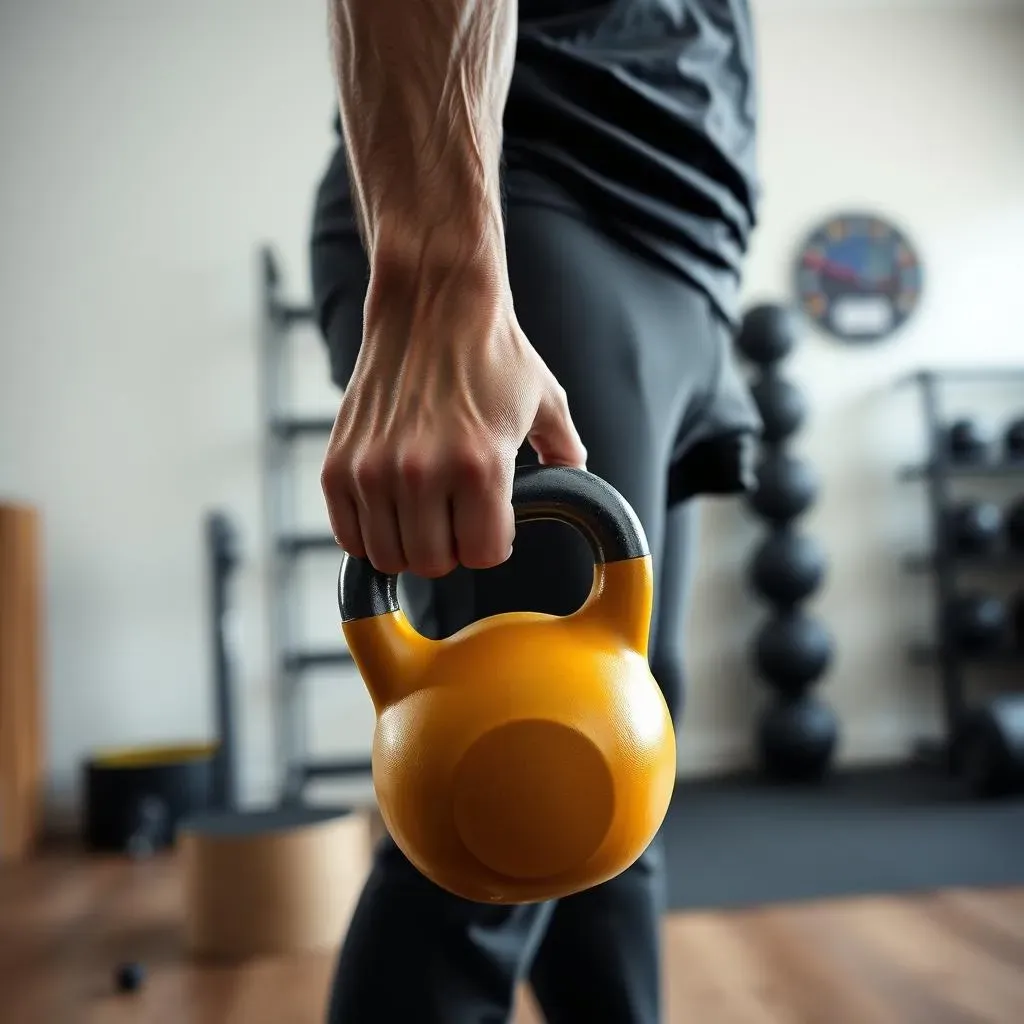Table of Contents
Ready to sculpt your dream physique without needing a fancy gym membership? Then get ready to unleash the power of kettlebells! This ultimate guide, complete with a handy "kettlebell exercises for beginners pdf," will take you from zero to hero in no time. We'll break down the fundamental exercises, ensuring you master proper form and technique to avoid injuries and maximize results. Forget confusing jargon – we'll keep it simple and fun, using clear explanations and helpful visuals. You'll discover how to build a full-body workout routine tailored to your fitness level, all from the comfort of your home. This isn't just another workout; it's a journey to a stronger, healthier, and more confident you. So grab your kettlebell (or find out what weight is right for you!), download your free "kettlebell exercises for beginners pdf", and let's get started! We'll cover everything from choosing the right kettlebell weight to crafting a personalized workout plan, ensuring you're fully equipped to achieve your fitness goals. Get ready to experience the kettlebell revolution!
Beginner Kettlebell Exercises PDF: Getting Started

Beginner Kettlebell Exercises PDF: Getting Started
Choosing Your Kettlebell
So, you're ready to dive into the world of kettlebells? Awesome! The first step is picking the right kettlebell. Don't worry, it's not as complicated as it sounds. For beginners, a lighter weight is your best friend. We're talking 8-12kg (18-26lbs) for most folks. You want something you can comfortably handle with good form. Think of it like this: it's better to start light and build up gradually than to injure yourself trying to be a hero on day one. Trust me, I've seen it happen. Remember, proper form is key, not how much weight you can lift. Check out this beginner's guide for more tips on selecting your kettlebell: Beginner Kettlebell Workout.
Starting with a lighter weight will allow you to focus on mastering the correct technique. You can always increase the weight as you get stronger. Think of it as learning to ride a bike – you wouldn't start with a mountain bike, would you? You'd start with a smaller bike and build up your skills before going for something more advanced. It's the same principle with kettlebells. A good starting point is to be able to perform 10-12 repetitions of each exercise with good form before increasing the weight. This ensures that you're building strength and endurance safely and effectively. Don't rush it!
Kettlebell Weight | Recommended for |
|---|---|
8-12 kg (18-26 lbs) | Most beginners |
12-16 kg (26-35 lbs) | Intermediate users |
16+ kg (35+ lbs) | Advanced users |
Mastering the Kettlebell Swing
The kettlebell swing is the cornerstone of many beginner kettlebell routines. It's a full-body exercise that works your posterior chain (glutes, hamstrings, back) and improves your cardiovascular fitness. It might seem simple, but getting the technique right is crucial. The goal isn't to fling the weight high; it's to harness the power of your hips to generate momentum. Imagine you're pushing through the ground with your legs, driving your hips forward, and letting the kettlebell swing naturally. This is a great resource for learning more about kettlebell swings: Best Kettlebell Workouts.
A common mistake is using your arms to lift the kettlebell. This can lead to injury and won't give you the same benefits. Focus on the hip hinge movement – think of it like a powerful pendulum. Start with a lighter weight and practice the movement slowly and deliberately, focusing on feeling the engagement in your glutes and hamstrings. As you get more comfortable, you can gradually increase your speed and the weight of your kettlebell. Remember to keep your core engaged throughout the movement to maintain stability and control. If you're unsure about your form, consider working with a qualified fitness professional to ensure you're performing the exercise correctly. It's always better to be safe than sorry!
- Keep your back straight.
- Engage your core.
- Power from your hips.
- Control the swing.
Getting Started with Your First Workout
Now that you've chosen your kettlebell and practiced the swing, it’s time to build your first workout! Don't go overboard; start with a simple routine that you can comfortably complete. A good starting point is a 20-30 minute workout, 2-3 times a week. Focus on quality over quantity – it's better to do fewer repetitions with perfect form than many with sloppy form. Remember, consistency is key. This beginner kettlebell workout can guide you.
Include exercises like the kettlebell swing, goblet squats (holding the kettlebell close to your chest while squatting), and rows (pulling the kettlebell towards your body). Start with 2-3 sets of 10-12 repetitions for each exercise. Listen to your body; if you're feeling pain, stop immediately. Rest for a day or two between workouts to allow your muscles to recover. As you get stronger, you can gradually increase the number of sets, repetitions, or the weight of your kettlebell. Remember, you're building a foundation, so patience and consistency are your allies. You can find a complete beginner’s program here: Beginners Kettlebell Workout.
Mastering Essential Kettlebell Exercises for Beginners (PDF Included)

Mastering Essential Kettlebell Exercises for Beginners (PDF Included)
Goblet Squats: A Foundation of Strength
Next up is the goblet squat, a fantastic exercise for building lower body strength and improving balance. Hold the kettlebell close to your chest, like you're cradling a precious pumpkin (because, well, your gains are precious!). Squat down until your thighs are parallel to the ground, keeping your back straight and your core engaged. Push through your heels to return to a standing position. This is a fundamental exercise that builds a solid base for more advanced movements. For more variations, check out this guide on beginner arm workouts.
Remember, control is key. Don't bounce at the bottom of the squat; instead, focus on a smooth, controlled movement. If you're feeling wobbly, try reducing the weight or widening your stance slightly. The goblet squat is a great way to build strength and improve your overall body awareness, setting you up for success in more challenging exercises. It's a simple exercise, but done correctly, it can make a huge difference in your fitness journey. Consistency is everything, so keep practicing!
- Hold kettlebell close to chest
- Squat until thighs parallel to ground
- Keep back straight, core engaged
- Push through heels to stand
Kettlebell Rows: Building Upper Body Strength
Now let's tackle kettlebell rows, a fantastic exercise for building upper body strength and improving posture. Start by hinging at your hips, keeping your back straight and your core engaged. Grab the kettlebell with one hand, letting it hang down towards the ground. Pull the kettlebell towards your chest, squeezing your shoulder blades together. Slowly lower the kettlebell back to the starting position. This exercise works your back, biceps, and forearms, contributing to a well-rounded physique. For a more comprehensive full-body approach, check out our full body kettlebell workout.
Remember to maintain a controlled movement throughout the exercise. Avoid jerking the kettlebell; instead, focus on a smooth, deliberate pull. If you're feeling strain in your lower back, you may be rounding your back too much; focus on keeping your core engaged. The kettlebell row is a versatile exercise that can be modified to suit different fitness levels. Start with a lighter weight and gradually increase as you gain strength and confidence. Focus on proper form to prevent injuries and maximize results. Remember, slow and steady wins the race!
Exercise | Sets | Reps |
|---|---|---|
Goblet Squats | 3 | 10-12 |
Kettlebell Rows | 3 | 8-10 (each side) |
Building Your First Kettlebell Workout Routine: A Beginner's PDF Guide

Building Your First Kettlebell Workout Routine: A Beginner's PDF Guide
Crafting Your First Workout Plan
Alright, let's build your first killer kettlebell workout! Remember, consistency trumps intensity, especially when starting. Aim for 2-3 sessions a week, allowing ample rest days for muscle recovery. Each workout should last around 20-30 minutes, focusing on quality over quantity. We're building a strong foundation here, not pushing for immediate exhaustion. This beginner full body workout is a great starting point.
Start with a warm-up – 5-10 minutes of light cardio and dynamic stretches. Then, incorporate the exercises we've already covered: kettlebell swings, goblet squats, and rows. Begin with 2-3 sets of 10-12 repetitions for each exercise. Listen to your body; if anything feels off, stop and rest. End with a cool-down, including static stretches to improve flexibility and reduce muscle soreness. Remember, proper form is paramount; focus on quality over quantity. You can find more inspiration in our kettlebell workouts for women guide.
- Warm-up (5-10 minutes)
- Kettlebell Swings (2-3 sets of 10-12 reps)
- Goblet Squats (2-3 sets of 10-12 reps)
- Kettlebell Rows (2-3 sets of 8-10 reps per side)
- Cool-down (5-10 minutes)
As you progress, you can increase the number of sets, reps, or the weight of your kettlebell. Don’t be afraid to experiment and find what works best for you. Remember, consistency is key to seeing results. If you're struggling to stay motivated, try finding a workout buddy or joining a fitness community. Having someone to hold you accountable can make a big difference. A well-structured plan, like our beginner kettlebell program, will help.
Remember, this is your journey. Embrace the process, celebrate your progress, and don’t be afraid to adjust your routine as needed. The most important thing is to find a workout you enjoy and can stick with. If you’re looking for more advanced routines, check out our ultimate beginner routine. Remember to always listen to your body and prioritize proper form over lifting heavy weights. This will help you avoid injuries and maximize your results. Have fun and stay consistent!
Week | Workout Focus | Rest Days |
|---|---|---|
1 | Focus on form and mastering the basic exercises | 2-3 days |
2 | Gradually increase reps or sets | 2-3 days |
3 | Consider increasing the kettlebell weight | 2-3 days |